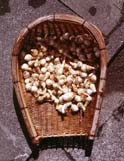研究テーマ・トピックス|ピーター J. マシウス

- Taro field, Hanalei valley, Hawai'i

- Cleaning taro in Paphos, Cyprus

- Washed taro, Nigata, Japan
For the last 20 years, my research has been focused on the history and prehistory of taro. This is an ancient, starchy root-crop in Asia, Africa and the Pacific.
"Taro" is a Polynesian name commonly used in English.Other names are "sato-imo" (in Japanese), "qolqas" and "kol okasi" (Arabic andGreek), and Colocasia esculenta (the Latin botanical name).
Many different taro cultivars are grown in temperate and tropical environments around the world.
In Japan and the Eastern Mediterranean, I have been using ethnobotanical approaches to investigate the production, storage and culinary culture of taro.
My other research includes a study of archaeological plant remains in Papua New Guinea, and a review of the history of paper mulberry, the main plant used for hand-made paper in Eastern Asia, and for tapa (barkcloth) in Southeast Asia and the Pacific.
The general aims behind my work are to (i) learn how people interact with plants and the natural world, (ii) encourage awareness of plants that are not already well-known and major commercial crops, and (iii) encourage the preservation and development of local knowledge associated with these plants.
 At Limassol Castle
At Limassol Castle
Dr. Matthews at Limassol Castle, a Byzantine fort in Cyprus, and the likely location of the wedding feast of Richard the Lionheart, King of England, and his wife Berengaria, on May 12th, 1191. A local oral tradition suggests that taro (kol okasi) was served at this feast. Taro is still commonly served at weddings in Cyprus today.

